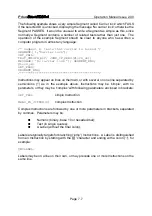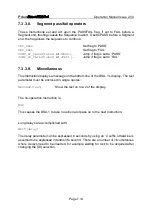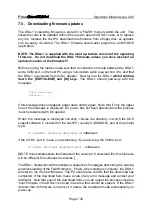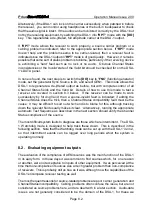
Prism
Operation Manual Issue 2.00
Page 7.21
7.4. Automated and Remote operation
NOTE: The DSA-1 RS-232 port has the same pinout as a PC-AT COM port, so a null-
modem cable (see section 3.6) should be used for Serial Slave operation (if the
controlling device is an IBM-compatible PC), and for Macro Processor operation.
7.4.1.
Serial Slave mode
Serial Slave mode allows the DSA-1 to be remote-controlled via its RS-232 port. This
means that automatic test systems can use a DSA-1 without operator intervention.
Writing a controller application program to use a DSA-1 in Serial Slave mode is a
difficult programming task and is not recommended to the novice. To conduct
automatic tests using the DSA-1 under control of a host PC, the Macro Processor
software described below makes the job very much easier.
In Serial Slave mode, the DSA-1 accepts 'key strokes' from the serial input as well as
from the keypad, and echoes all LED and display information to the serial output.
Serial Slave mode may is invoked and terminated by the external device (typically a
host PC) sending special character strings to the DSA-1. Note that this cannot occur
when the DSA-1 is in Host Mode (sub-menu 9.5.), nor should Host Mode be entered
when Serial Slave mode is active.
For experienced programmers, the serial protocols for entering and operating Serial
Slave mode are covered in appendix B.
7.4.2.
Macro Processor software
7.4.2.1.
Introduction
The Macro Processor is an MS-DOS application which is used to operate the DSA-1
automatically. The Macro Processor invokes Serial Slave mode in the DSA-1, then
sends sequences of DSA-1 key-press tokens to the unit to control its actions. Results
from the DSA-1's display and LEDs can be read and processed, and output can be sent
to printer, file or serial port (other than the port to which the DSA-1 is connected).
The Macro Processor operates on a Macro File, which is prepared by the user. This
is a simple ASCII text file containing the instructions ('Keywords') used to control the
DSA-1 and act on its results. Macro Files can be prepared using any simple text editor,
such as MS-DOS 'EDIT' or MS-Windows 'NOTEPAD'.
















































